.

This May 10, 2015, view from Curiosity's Mastcam shows terrain judged difficult for traversing between the rover and an outcrop in the middle distance where a pale rock unit meets a darker rock unit above it. The rover team decided not to approach this outcrop and identified an alternative.
.
NASA's Curiosity Mars rover climbed a hill Thursday to approach an alternative site for investigating a geological boundary, after a comparable site proved hard to reach.
The drive of about 72 feet (22 meters) up slopes as steep as 21 degrees brought Curiosity close to a target area where two distinctive types of bedrock meet. The rover science team wants to examine an outcrop that contains the contact between the pale rock unit the mission analyzed lower on Mount Sharp and a darker, bedded rock unit that the mission has not yet examined up close.
Two weeks ago, Curiosity was headed for a comparable geological contact farther south. Foiled by slippery slopes on the way there, the team rerouted the vehicle and chose a westward path.The mission's strategic planning keeps multiple route options open to deal with such situations.
.
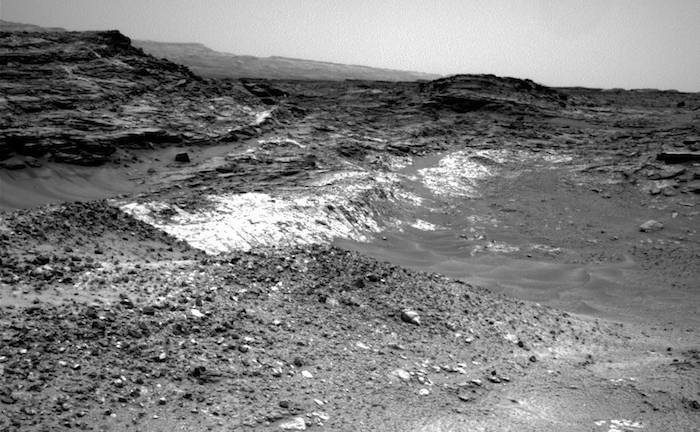
The Martian outcrop where pale rock meets darker overlying rock near the middle of this May 21, 2015, view is an example of a geological contact. Such contacts can reveal clues about how environmental conditions that produced one type of rock were related to conditions that produced the other.
.
"Mars can be very deceptive," said Chris Roumeliotis, Curiosity's lead rover driver at NASA's Jet Propulsion Laboratory, Pasadena, California. "We knew that polygonal sand ripples have caused Curiosity a lot of drive slip in the past, but there appeared to be terrain with rockier, more consolidated characteristics directly adjacent to these ripples. So we drove around the sand ripples onto what we expected to be firmer terrain that would give Curiosity better traction. Unfortunately, this terrain turned out to be unconsolidated material too, which definitely surprised us and Curiosity."
In three out of four drives between May 7 and May 13, Curiosity experienced wheel slippage in excess of the limit set for the drive, and it stopped mid-drive for safety. The rover's onboard software determines the amount of slippage occurring by comparing the wheel-rotation tally to actual drive distance calculated from analysis of images taken during the drive.
The rover was heading generally southward from near the base of a feature called "Jocko Butte" toward a geological contact in the eastern part of the "Logan Pass" area.
Routes to this contact site would have required driving across steeper slopes than Curiosity has yet experienced on Mars, and the rover had already experienced some sideways slipping on one slope in this area.
"We decided to go back to Jocko Butte, and, in parallel, work with the scientists to identify alternate routes," Roumeliotis said.
The team spent a few days analyzing images from the rover and from NASA's Mars Reconnaissance Orbiter to choose the best route for short-term and long-term objectives.
"One factor the science team considers is how much time to spend reaching a particular target, when there are many others ahead," said Curiosity Project Scientist Ashwin Vasavada of JPL. "We used observations from NASA's Mars Reconnaissance Orbiter to identify an alternative site for investigating the geological contact in the Logan Pass area. It's a little mind-blowing to drive up a hill to a site we saw only in satellite images and then find it in front of us."
Curiosity has been exploring on Mars since 2012. It reached the base of Mount Sharp last year after fruitfully investigating outcrops closer to its landing site and then trekking to the mountain. The main mission objective now is to examine successively higher layers of Mount Sharp.
---
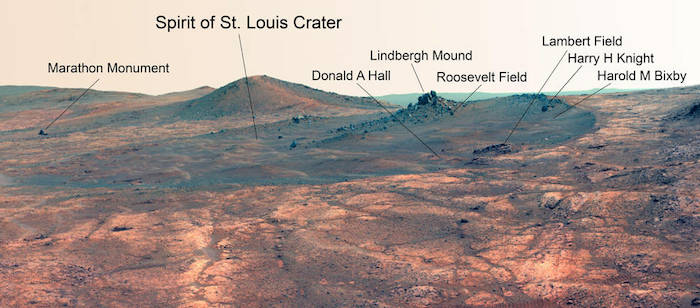
Names related to the first solo nonstop flight across the Atlantic have been informally assigned to a crater NASA's Opportunity Mars rover is studying. This false-color view of the "Spirit of St. Louis Crater" and the "Lindbergh Mound" inside it comes from Opportunity's panoramic camera.
.
NASA's Mars Exploration Rover Opportunity is studying an elongated crater called "Spirit of St. Louis" and a rock spire called "Lindbergh Mound" within the crater.
The crater and several features in and near it are shown in a recent image from Opportunity's panoramic camera (Pancam).
Throughout Opportunity's 11-plus years on Mars, the science team for the rover has picked crater names from a list of "vessels of exploration," including ships, spacecraft and aircraft. The names informally assigned for this crater and features in it refer to Charles Lindbergh's May 1927 flight from New York to Paris in the airplane he named Spirit of St. Louis, the first solo nonstop flight across the Atlantic.
.
Mars Rover's Laser-Zapping Instrument Gets Sharper Vision
.
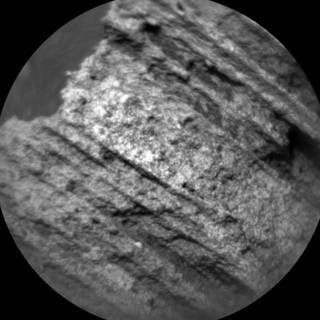
This May 15, 2015, image from the Chemistry and Camera (ChemCam) instrument on NASA's Curiosity Mars rover shows detailed texture of a rock target called "Yellowjacket" on Mars' Mount Sharp. This was the first rock target for ChemCam after checkout of restored capability for autonomous focusing.
.
Tests on Mars have confirmed success of a repair to the autonomous focusing capability of the Chemistry and Camera (ChemCam) instrument on NASA's Curiosity Mars rover.
This instrument provides information about the chemical composition of targets by zapping them with laser pulses and taking spectrometer readings of the induced sparks. It also takes detailed images through a telescope.
Work by the instrument's team members at Los Alamos National Laboratory in New Mexico and in France has yielded an alternative auto-focus method following loss of use of a small laser that served for focusing the instrument during Curiosity's first two years on Mars.
"Without this laser rangefinder, the ChemCam instrument was somewhat blind," said Roger Wiens, ChemCam principal investigator at Los Alamos. "The main laser that creates flashes of plasma when it analyzes rocks and soils up to 25 feet [7.6 meters] from the rover was not affected, but the laser analyses only work when the telescope projecting the laser light to the target is in focus."
For the past several months, the team has coped without auto-focusing. For each target, the instrument has taken multiple images or multiple laser analyses at different focal distances. The data were sent to Earth for selection of the in-focus image or laser analysis among the set.
The repair required sending new software to be installed on the instrument. It now takes multiple images and uses those to autonomously select the focus positions for the final images and laser analyses sent back to Earth.
"We think we will actually have better quality images and analyses with this new software than the original," said Wiens.
.
Diverse Grains in Mars Sandstone Target 'Big Arm'
.
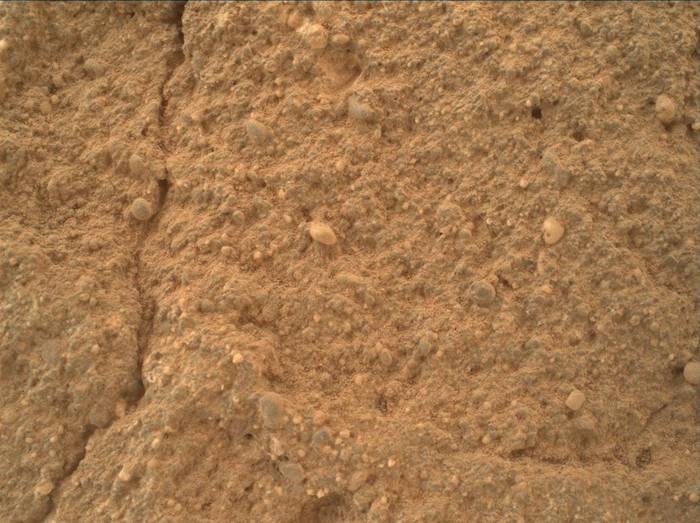
This view of a sandstone target called "Big Arm" covers an area about 1.3 inches (33 millimeters) wide in detail that shows differing shapes and colors of sand grains in the stone.
Three separate images taken by the Mars Hand Lens Imager (MAHLI) camera on NASA's Curiosity Mars rover, at different focus settings, were combined into this focus-merge view. The Big Arm target on lower Mount Sharp is at a location near "Marias Pass" where a mudstone bedrock is in contact with overlying sandstone bedrock. MAHLI recorded the component images on May 29, 2015, during the 999th Martian day, or sol, of Curiosity's work on Mars.
The rounded shape of some grains visible here suggests they traveled long distances before becoming part of the sediment that later hardened into sandstone. Other grains are more angular and may have originated closer to the rock's current location. Lighter and darker grains may have different compositions.
MAHLI was built by Malin Space Science Systems, San Diego. NASA's Jet Propulsion Laboratory, a division of the California Institute of Technology in Pasadena, manages the Mars Science Laboratory Project for the NASA Science Mission Directorate, Washington.
Credit: NASA/JPL-Caltech/MSSS
.
NASA's Curiosity Mars Rover Studies Rock-Layer Contact Zone
.
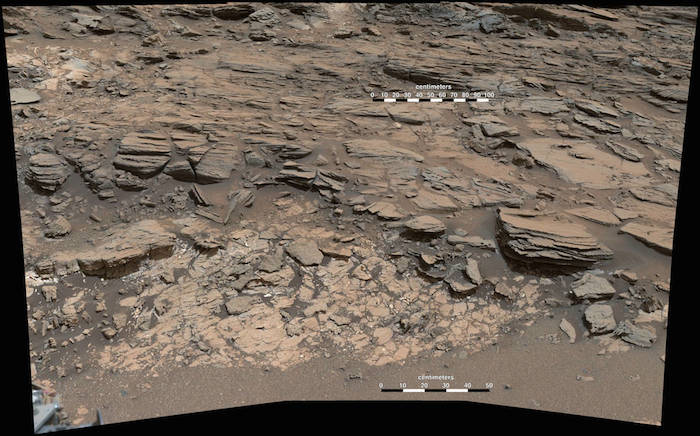
This May 25, 2015, view from the Curiosity rover's Mastcam shows a site where two different types of bedrock meet near "Marias Pass" on Mount Sharp. Pale mudstone in the foreground is like bedrock the rover studied at "Pahrump Hills." The darker sandstone above it is called the Stimson unit.
Credits: NASA/JPL-Caltech/MSSS
.
NASA's Curiosity Mars rover is examining a valley where at least two types of bedrock meet, for clues about changes in ancient environmental conditions recorded by the rock.
In addition to two rock types for which this site was chosen, the rover has found a sandstone with grains of differing shapes and color.
Curiosity's international team has resumed full operations of the car-size mobile laboratory after a period of limited activity during most of June. The operations moratorium for Curiosity and other spacecraft at Mars happens about every 26 months, when Mars passes nearly behind the sun from Earth's perspective, and the sun interferes with radio communication between the two planets.
At the rover's current location near "Marias Pass" on Mount Sharp, Curiosity has found a zone where different types of bedrock neighbor each other. One is pale mudstone, like bedrock the mission examined previously at "Pahump Hills." Another is darker, finely bedded sandstone above the Pahrump-like mudstone. The rover team calls this sandstone the Stimson unit.
On Mars as on Earth, each layer of a sedimentary rock tells a story about the environment in which it was formed and modified. Contacts between adjacent layers hold particular interest as sites where changes in environmental conditions may be studied. Some contacts show smooth transitions; others are abrupt.
Curiosity climbed an incline of up to 21 degrees in late May to reach Marias Pass, guided by images from NASA's Mars Reconnaissance Orbiter showing Pahrump-like and Stimson outcrops close together.
"This site has exactly what we were looking for, and perhaps something extra," said Curiosity Project Scientist Ashwin Vasavada, of NASA's Jet Propulsion Laboratory, Pasadena, California. "Right at the contact between the Pahrump-like mudstone and the Stimson sandstone, there appears to be a thin band of coarser-grained rock that's different from either of them."
The in-between material is a sandstone that includes some larger grains, of mixed shapes and colors, compared to the overlying dark sandstone.
"The roundedness of some of the grains suggests they traveled long distances, but others are angular, perhaps meaning that they came from close by," Vasavada said. "Some grains are dark, others much lighter, which indicates that their composition varies. The grains are more diverse than in other sandstone we've examined with Curiosity."
The science team has identified rock targets for further close-up inspection of the textures and composition of the mudstone and sandstone exposed near Marias Pass. The team ancipates keeping Curiosity busy at this site for several weeks before driving higher on Mount Sharp.
Curiosity has been exploring on Mars since 2012. It reached the base of Mount Sharp last year after fruitfully investigating outcrops closer to its landing site and then trekking to the mountain. The main mission objective now is to examine successively higher layers of Mount Sharp.
-
Panorama from Curiosity's Sol 1000 Location
.

This 360-degree panorama from the Navigation Camera (Navcam) on NASA's Curiosity Mars rover shows the surroundings of a site on lower Mount Sharp where the rover spent its 1,000th Martian day, or sol, on Mars.
Sol 1,000 of Curiosity's Mars-surface mission corresponded to May 30, 2015. The component images for this scene were taken on Sol 997 (May 27, 2015). The site is a valley just below "Marias Pass" on lower Mount Sharp.
Quelle: NASA
4788 Views
